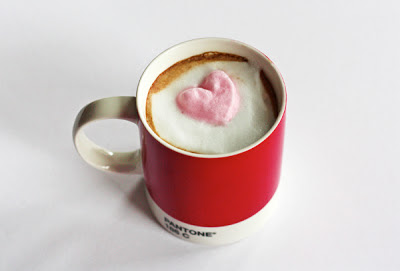We were goofing around in the kitchen this weekend and decided it would be fun to make colored milk froth for our lattes. Here's a pink heart that I glopped on with a spoon and shaped with a toothpick.
I think I need a little more practice. But we amused ourselves. Alex often tries to make me a stiff foam 3D cat with pointy ears that looks as if it's half submerged in the cup. I always get a kick out of that one.
He's the foam master. We make stovetop espresso in our Bialetti pot and add hot milk, and then he uses a $2.99 frother from IKEA to make foam. I've tried and can't get it nearly as nice as his. So asked, and here's his method, with direct quotes. Keep in mind this man is an engineer.
Heat about 1/4 cup of milk in the microwave on high until it's just about to boil. At the first hint of bubbles, stop. (About 45 seconds.)
Don't scorch the milk. "It denatures the proteins and changes the flavor profile." Oh, okay. "You have to keep an eye on it, so put your face right up to the microwave door. You'll risk microwave exposure, but it's necessary." Sure, no problem. A good latte is worth it. Heat your milk on the stove if this idea bothers you.
Update! From FKMN's husband in the comments: "The milk must never get above 65 degrees Celcius [149 F] — that will start the milk sugar (lactose) caramelizing and completely change the flavour of the milk and resulting latte." Whoa, good to know. So don't microwave it so long.
Then put the frothing wand in the hot milk and run it for 30 seconds or less. "The key to getting the right foaming consistency that you like is a combination of cup tilting and moving the frother in and around. I like to move the frother in a circular pattern so that new areas of the milk get hit with the shearing motion."
Shearing motion. Got it.
Then let the foam sit about 30 seconds, and it will stiffen up. "You can wait a little longer, but at some point the foam cells start to break down."
Spoon the foam onto your latte.
To make colored foam, add one or two drops of food coloring to the hot milk before you froth it.
I think I need a little more practice. But we amused ourselves. Alex often tries to make me a stiff foam 3D cat with pointy ears that looks as if it's half submerged in the cup. I always get a kick out of that one.
He's the foam master. We make stovetop espresso in our Bialetti pot and add hot milk, and then he uses a $2.99 frother from IKEA to make foam. I've tried and can't get it nearly as nice as his. So asked, and here's his method, with direct quotes. Keep in mind this man is an engineer.
Heat about 1/4 cup of milk in the microwave on high until it's just about to boil. At the first hint of bubbles, stop. (About 45 seconds.)
Don't scorch the milk. "It denatures the proteins and changes the flavor profile." Oh, okay. "You have to keep an eye on it, so put your face right up to the microwave door. You'll risk microwave exposure, but it's necessary." Sure, no problem. A good latte is worth it. Heat your milk on the stove if this idea bothers you.
Update! From FKMN's husband in the comments: "The milk must never get above 65 degrees Celcius [149 F] — that will start the milk sugar (lactose) caramelizing and completely change the flavour of the milk and resulting latte." Whoa, good to know. So don't microwave it so long.
Then put the frothing wand in the hot milk and run it for 30 seconds or less. "The key to getting the right foaming consistency that you like is a combination of cup tilting and moving the frother in and around. I like to move the frother in a circular pattern so that new areas of the milk get hit with the shearing motion."
Shearing motion. Got it.
Then let the foam sit about 30 seconds, and it will stiffen up. "You can wait a little longer, but at some point the foam cells start to break down."
Spoon the foam onto your latte.
To make colored foam, add one or two drops of food coloring to the hot milk before you froth it.



No comments:
Post a Comment